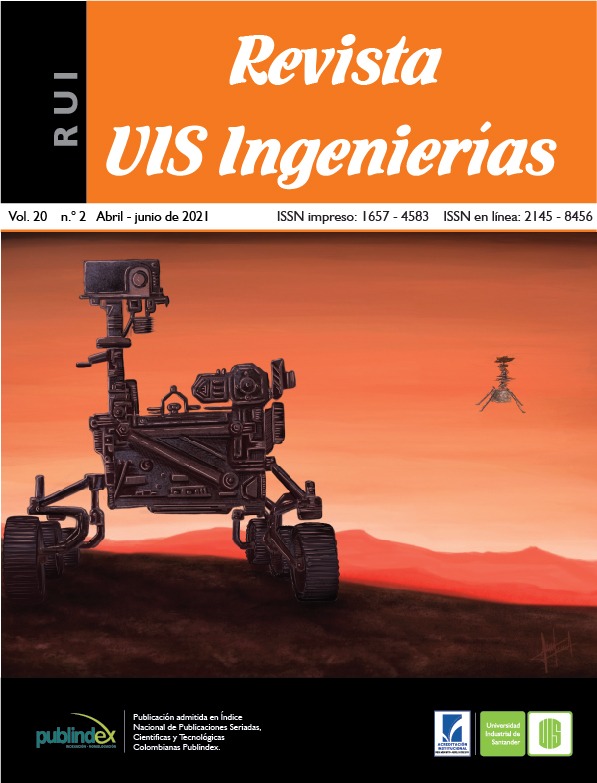Published 2021-01-02
Keywords
- test bench,
- isolated photovoltaic solar energy,
- laboratory practices,
- solar panel performance
How to Cite
Abstract
With the construction of this test bench, it is possible to characterize autonomous photovoltaic solar systems and measure the performance of photovoltaic solar panels. This test bench allows students and users to know the components of an isolated photovoltaic system for homes and to validate the operation of each one of them; protection component, connections, DC-AC transformation component, among others. The bench was designed to carry out different laboratory practices, such as: identifying and evaluating the operating curve of the panels according to the radiation received, measuring the output voltage and current of the system according to its series and parallel connections, making connections for direct current or alternating current, among others. The most complex and relevant practice is the measurement of the performance of solar panels, since resistors with a different capacity must be included to create the current vs. voltage curve (I vs. V); An electronic circuit was designed where the panel is connected to a variable resistive load and the value of current and voltage is recorded. For voltage measurement the multimeter is connected in parallel in the circuit and for amperage measurement it is connected in series. Some of the most important results of the practices were; being able to identify the significant variation in the efficiency of solar panels as the position of the sun changes, Identify how temperature affects the performance of the panel and determine the exceptional conditions in which a panel generates the energy specified by the manufacturer.
Downloads
References
[2] E. Durán, M. Piliougine, M. Sidrach-de-Cardona, J. Galán, J. M. Andújar, “Different methods to obtain the I–V curve of PV modules: A review”, en Conference Record of the IEEE Photovoltaic Specialists Conference, 2008, pp. 1-6, doi: 10.1109 / PVSC.2008.4922578
[3] R. Lauretta, “Interviewee, El ingeniero debe formarse en energías renovables”, Instituto Tecnológico de Buenos Aire, 2017 [En línea]. Disponible en: https://www.itba.edu.ar/el-ingeniero-debe-formarse-en-energias-renovables/
[4] U. J. Barbosa, M. A. Mayorga, S. W. Santamaria, D. M. García, “Iluminación con energía solar fotovoltaica para autoservicios en Bogotá”, Ingenio Magno, vol. 5, no. 1, pp. 81-94, 2014.
[5] E. J. Velásquez Solano, J. B. Solano Rodríguez, “Banco de pruebas de energía solar fotovoltaica con el fin de generar energía eléctrica para las luminarias de la Plazoleta a la Vida de la Universidad Francisco de Paula Santander, Ocaña”, tesis doctoral, Universidad Francisco de Paula Santander, 2015.
[6] A. López, C. Montoya, “Prototipo de laboratorio que permite verificar parámetros técnicos en paneles”, trabajo de grado, Universidad de San Buenaventura, 2017.
[7] S. A. H. Moreno, E. R. Ramirez, A. D. L. Bonilla, G. G. M. Contreras, B. F. O. García, “Characterization of a monocrystalline photovoltaic solar panel with cooling to improve its performance”, Technology, vol. 10, no. 11, pp. 297-306, 2019.
[8] A. Durán, B. Romero, “Estudio de reconocimiento sobre la Energía Solar”, tesis de grado, Universidad Distrital Francisco José de Caldas, 2016.
[9] H. Amirya, M. Benhmidaa, R. Bendaouda, C. Hajjaja, S. Bounouara, S. Yadira, K. Raïsa, M. Sidkia, “Design and implementation of a photovoltaic I-V curve tracer: Solar modules characterization under real operating conditions”, Energy Conversion and Management, vol. 169, no. 1, pp. 206-216, 2018, doi: 10.1016/j.enconman.2018.05.046
[10] F. P. Gasparin, A. J. Bu¨hler, G. A. Rampinelli, A. Krenzinger, “Statistical analysis of I–V curve parameters from photovoltaic modules”, Solar Energy, vol. 131, pp. 30-38, 2016, doi: 10.1016/j.solener.2016.01.061
[11] T. Khatib, A. Ghareeb, M. Tamimi, M. Jaber, y S. Jaradat, “A new offline method for extracting I-V characteristic curve for photovoltaic modules using artificial neural networks”, Solar Energy, vol. 173, pp. 462-469, 2018, doi: 10.1016/j.solener.2018.07.092
[12] A. M. Silva, F. C. Melo, J. H. Reis, L. C.G. Freitas, “The study and application of evaluation methods for photovoltaic modules under real operational conditions, in a region of the Brazilian Southeast”, Renewable Energy, vol. 138, pp. 1189-1204, 2019, doi: 10.1016/j.renene.2019.01.129
[13] R. García-Valverde, S. Chaouki-Almagro, M. Corazza, N. Espinosa, M. Hösel, R. R. Søndergaard, M. Jørgensen, J. A. Villarejo, F. C. Krebs, “Portable and wireless IV-curve tracer for >5 kV organic photovoltaic modules”, Solar Energy Materials and Solar Cells, vol. 151, pp. 60-65, 2016, doi: 10.1016/j.solmat.2016.02.012
[14] J. Polo, N. Martín-Chiveleta, M. C. Alonso-García, H. Zitouni, Miguel Alonso-Abella, C. Sanz-Saiza, y N. Vela-Barrionuevoa, “Modeling I-V curves of photovoltaic modules at indoor and outdoor conditions by using the Lambert function. Energy Conversion and Management”, vol. 195, no. 1, pp. 1004-1011, 2019, doi: 10.1016/j.enconman.2019.05.085
[15] E. R. Ramirez, S. A. H. Moreno, M. E. R. Soler, G. G. M. Contreras, R. B. León, “Learning of autonomous photovoltaic solar energy through a didactic test bench”, International Journal of Mechanical Engineering and Technology, vol. 10, no. 10, pp. 263-271, 2019.
[16] Measurement Principles of PV Current Voltage Characteristics, IEC 904-1.
[17] I. D. Mendoza Jiménez, E. A. Torres Suárez, “Construcción de un banco de pruebas solar fotovoltaico para el laboratorio de ingeniería mecánica de la Universidad Santo Tomás Tunja”, trabajo de grado, Universidad Santo Tomás, 2019.


